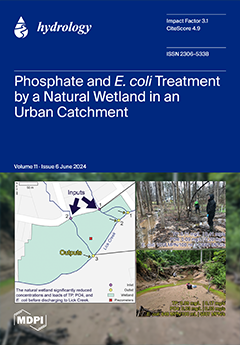The physical integrity of the Ngerengere River and its three tributaries drains within Morogoro Municipality were evaluated by assessing the variations in land-use–land cover (LULC) in the river’s buffer zone, the discharge, and the contamination of river water and sediment from nutrients and
[...] Read more.
The physical integrity of the Ngerengere River and its three tributaries drains within Morogoro Municipality were evaluated by assessing the variations in land-use–land cover (LULC) in the river’s buffer zone, the discharge, and the contamination of river water and sediment from nutrients and heavy metals. Integrated geospatial techniques were used to classify the LULC in the river’s buffer zone. In contrast, the velocity area method and monitoring data from the Wami-Ruvu Basin were used for the discharge measurements. Furthermore, atomic absorption spectrophotometry was used during the laboratory analysis to determine the level of nutrients and heavy metals in the water and river sediment across the 13 sampling locations. The LULC assessment in the river’s buffer during the sampling year of 2023 showed that bare land and built-up areas dominate the river’s buffer, with a coverage of 28% and 38% of the area distribution. The higher discharge across the sampling stations was in the upstream reaches at 3.73 m
3/s and 2.36 m
3/s at the confluences. The highest concentrations of heavy metals in the water for the dry and wet seasons were 0.09 ± 0.01, 0.25 ± 0.01, 0.03 ± 0.02, 0.73 ± 0.04, 4.07 ± 0.08, and 3.07 ± 0.04 mg/L, respectively, for Pb, Cr, Cd, Cu, Zn, and Ni. The order of magnitude of the heavy metal concentration in the sediments was Zn > Ni > Cr > Cu > Cd > Pb, while the highest NO
2−, NO
3−, NH
3, and PO
43− in the water and sediment were 2.05 ± 0.01, 0.394 ± 0.527, 0.66 ± 0.05, and 0.63 ± 0.01 mg/L, and 2.64 ± 0.03, 0.63 ± 0.01, 2.36 ± 0.01, and 48.16 ± 0.01 mg/kg, respectively, across all sampling seasons. This study highlights the significant impact of urbanization on river integrity, revealing elevated levels of heavy metal contamination in both water and sediment, the variability of discharge, and alterations in the LULC in the rivers’ buffer. This study recommends the continuous monitoring of the river water quality and quantity of the urban rivers, and the overall land-use plans for conserving river ecosystems.
Full article





